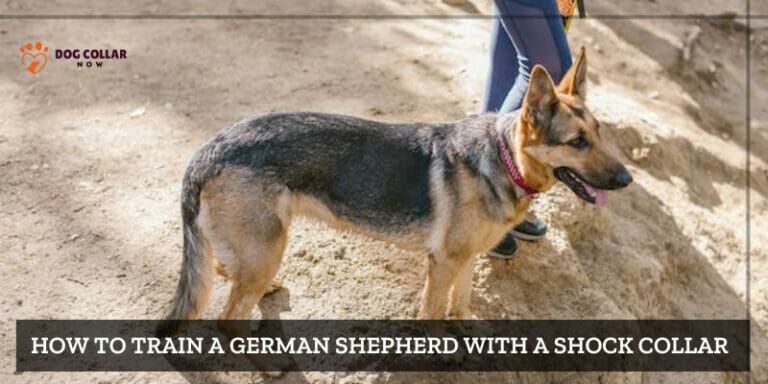Electric Dog Fence vs Shock Collar – What Is Better Option

Pet owners commonly used electric dog fences and shock collars to train their dogs. Both training methods work on the basis of delivering an electric shock to the dog when it behaves undesirably.
When comparing an electric dog fence to a shock collar, the key difference lies in its purpose.
An electric dog fence creates an invisible boundary using wires and a collar, giving a gentle reminder to the dog not to cross over. On the other hand, a shock collar delivers a small electric shock to discourage undesired behavior in the dog.
Now, let’s compare the two options electric dog fence vs shock collar, and explore their pros and cons. While both electric dog fences and shock collars serve the purpose of training collars and containment, they differ significantly in their approach.
Electric Dog Fence Vs Shock Collar – What’s The Difference Between
When it comes to training dogs, there are various methods available in the market. Two commonly used options are electric dog fences and shock collars. Although they may seem similar, there is a distinct difference between these two training tools.
An electric dog fence is a system that helps contain your pet within a designated boundary without having to physically install barriers like walls or fences. On the other hand, a static collar is worn around your dog’s neck and delivers electrical stimulation when triggered by remote control.
The primary difference between the two lies in their purpose of use. Electric dog fences help keep your pet contained in one area while allowing them some freedom of movement within that space, whereas static collars aim at correcting negative behavior through punishment.
Furthermore, electric dog fences have no side effects as long as you train your pets properly, whereas there may be harmful consequences with using shock collars such as physical injury or mental stress on animals.
It’s essential to understand both options thoroughly before deciding which option works best for you and your furry friend based on their temperament and individual needs.
Electric Dog Fence
Pros Of Electric Dog Fence
Electric dog fences offer several benefits for pet owners.
- Safe and secure containment without physical barriers.
- Versatile for large or small yards, customizable.
- Virtually invisible fence doesn’t obstruct views or aesthetics.
- More affordable than traditional fencing options.
- Low maintenance, saves money in the long run.
- Easy DIY installation, no need for professional help.
Cons Of Electric Dog Fence
Electric dog fences are a popular choice for dog owners who want to keep their dogs safe within the boundaries of their property. While they offer many benefits, there are also some cons that need to be considered.
- Can cause fear and anxiety in dogs.
- Doesn’t prevent other animals from entering.
- Regular maintenance and costly repairs.
- Lack of visual cues for pets.
- Shock can lead to behavioral problems.
- Dogs may run out to chase or defend.
- Extra expenses for batteries or electricity.
- Training takes time and patience from both.
Types Of Electric Dog Fences
There are different types of electric dog fences that you can choose from for your furry friend. Each type has its own features and advantages, depending on the size of your yard and how much control you want to have over your dog’s movements.
- Underground wire: Invisible boundary with a buried wire.
- Wireless fence system: No wires, creates a circular boundary.
- Hybrid systems: Combines wired and wireless technology.
- In-ground containment: Uses physical barriers with electric options.
- GPS-based systems: Allows for flexible boundaries and portability.
- Virtual barrier systems: Utilizes advanced technology for precise containment.
- Indoor electric fences: Keeps pets within designated indoor areas.
2) Shock Collar
Pros Of Shock Collar
Electronic training collars have been a controversial topic in the world of dog training, but there are some pros to using them
- Corrects dangerous behaviors like chasing or attacking.
- Long-distance control for walks or playtime.
- Remote control options for quick corrections.
- Prevents dogs from running into traffic or getting lost.
- Helps hunting dogs stay on track and near their owners.
- Use as a last resort after other methods.
- Consult a professional trainer for proper use.
Cons Of Shock Collar
While shock collars may seem like a quick fix for your dog’s behavior issues, there are many cons to using them.
- Risk of physical harm and psychological trauma.
- Focuses on punishment, not positive reinforcement.
- Malfunctioning collars can cause unnecessary distress.
- Dogs may develop fears associated with the collars.
- Banned in some countries for animal welfare concerns.
- Consider alternatives before using shock collars.
- Assess the situation and consult professionals wisely.
Types Of Shock Collar
When it comes to shock collars, there are various types available in the market. Each type has its own unique features and functionalities.
- Static shock collar: Delivers a mild electric shock.
- Spray collar: Emits a burst of citronella or other scents.
- Vibration collar: Provides a gentle vibrating sensation.
- Ultrasonic collar: Emits high-frequency sound waves.
- Combination collar: Offers multiple correction options in one.
- Remote control collar: Allows manual control from a distance.
- Bark-activated collar: Activates when the dog barks.
Factors To Consider While Buying Electric Dog Fence Vs Shock Collar
When deciding between an electric dog fence and a shock collar, there are several factors to consider before making your purchase.
Temperament Of Dog:
Firstly, it’s important to consider the temperament of your dog. If you have a nervous or anxious dog, a shock collar may not be the best option as it can potentially increase their anxiety levels and cause further behavioral issues.
Size Of Property:
Secondly, the size of your property is also important to take into account. Electric dog fences are better suited for larger properties with more space for dogs to roam freely. Shock collars may work well in smaller areas where precision control is needed.
Training Process:
Thirdly, consider the training process involved with each option. An electric dog fence requires consistent training over time so that dogs understand boundaries while a shock choker relies on immediate feedback which can be too harsh if used incorrectly.
Consult With Trainers
Fourthly, always consult with trainers or veterinarians before using either method as they can recommend alternative options or help you decide whether these methods would be appropriate for your pet.
Make sure you choose high-quality products from reputable brands and follow all instructions carefully when setting up and using either device.
Electric Dog Fence Vs Shock Collar- What Is the Better Option
When deciding between an electric dog fence and a shock collar, it can be quite a challenge. Each option has its own advantages and disadvantages, making it tough to pick a clear winner.
For some pet owners, an electric dog fence is the way to go. It creates an invisible boundary using radio signals, keeping your dog safe without causing any pain. Imagine, your pup gets a gentle warning or vibrations when they approach the boundary line – no harm done!
On the other hand, shock collars offer a more immediate training solution for some pet owners. They deliver static stimulation that can range from mild vibrations to stronger sensations when needed. It’s like having a handy tool to teach your dog right from wrong in no time!
Remember, both options need careful consideration. Choose what suits your needs and your furry friend’s preferences the best.
Conclusion
Choosing between an electric dog fence vs shock collar can be a tough decision for pet owners. Both have their advantages and disadvantages, but ultimately the best option depends on individual circumstances.
Electric dog fences offer a safe containment option using mild static shocks. Shock collars are primarily used for behavioral training. Caution and appropriate training are essential for both methods.
While both electric dog fences and shock collars have their benefits in certain situations, responsible use is key to ensuring your pet’s safety and well-being. It is essential that every owner conducts proper research into these products before making any final decisions regarding containment or behavioral training methods for their beloved furry friends.
FAQs
Can I use both an electric dog fence and a shock collar for my dog?
Yes, you can use both an electric dog fence and a shock collar for your dog. However, it is important to note that the two systems serve different purposes, and should not be used interchangeably.
Are electric dog fences safe for my dog?
Yes, electric dog fences are safe for most dogs. When used correctly and installed properly, electric dog fences pose no danger to your dog’s health.
What is a shock collar for dogs?
A shock collar for dogs, also known as a training collar or e-choker, is a device designed to deliver an electric shock to a dog’s throat in order to correct unwanted behavior.
Will an electric dog fence stop my dog from barking?
No, an electric dog fence is not designed to stop your dog from barking. It is solely meant to contain your dog within a certain perimeter.








